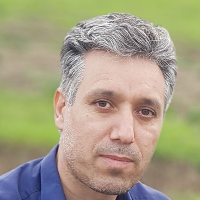Effect of Plant Growth Regulators and Ultrasound on the Bulblet Production and Root Induction in Lilium ledebourii
Author(s):
Article Type:
Research/Original Article (دارای رتبه معتبر)
Abstract:
Introduction
Lily (L. ledebourii) is the rarestspeciesof thegenusLilium, and grows in Caucasus region. Iranis one of the important distribution areas of this endangered species. It is important as an ornamental plant due to its large and attractive white flowers that are equal to those of commercial lilies in terms of beauty.The two main constraints on growing this plant are a low multiplication rate and the high cost of bulb production. Five to ten flowers commonly appear on each plant, even specimens with up to 15 flowers have been observed. Plant tissue culture techniques are widely used in plant propagation and using these methods can effectively provide micro-propagation of this plant in large scale. High percentage ofregeneration is necessary for plant protection, using in the breeding programs and gene transfer to this plant. Therefore, the effect of plant growth regulators and abiotic stress (ultrasound) werestudied on the bulblet production and root induction of Lilium ledebourii.Materials And Methods
The experiment was factorial based on completely randomized design with four replicattions and was carried out in tissue culture lab of University of MohagheghArdabili in 2015. For this purpose, segmentsof scale explant was treated with ultrasound and cultured on MS medium supplemented with different concentrations of NAA and BA alone and/or in combination with each other. In this experiment, different concentrations of NAA (0, 0.01, 0.1 and 1 mgl-1) and BA (0, 0.01, 0.1 and 1 mgl-1) and different Ultrasound exposure duration (0, 5, 10, 20 and 30 second) were studied. In order to remove possible contamination from the media, all media were autoclaved for 20 minutes at 121 °C. At the end of the experiment, the number of bulblet, root length, fresh weight of bulblet were recorded. The cultures were kept at 25±2°C under illumination with daylight fluorescent lamps (30 mol m-2s-1) at 16 h photoperiod. Data was subjected for analysis of variance and compare means using SPSS 16.Results And Discussion
The results showed that ultrasound had negative effect onroot length, so that the highest root length was observed in explants without ultrasound treatment. Result also indicated that ultrasound had positive effect on bulblet production and root induction. A different effect of growth regulators was observed in similar media on the bulblet formation percentage. The 0.1 NAA concentration had a higher efficiency while increasing NAA insignificantly decreased bulblet induction. The highest total weight and number of bulblets obtained by 0.1 mgl-1 NAA. Concentrations of NAA increased rooting percentage. Different concentrations of NAA had also significant effects on some traits. So that, the highest weight of bulblets obtained by 0.01 and 0.1 mgl-1 BA and the highest number of roots obtained in control. Bulblet maximum mean weightwas in30 seconds ofultrasoundtreatment, which hada significantdifference with the control treatment (without ultrasoundtreatment). In the other hand, ultrasound increased the number and weight of bulblets.Mechanical stress and microstreaming by acoustic cavitation might be considered as the most possible cause of the various physiological effects of ultrasound on cells. The enhancement of V-ATPase transport and ATP hydrolysis activities seem to be an ultrasound-induced metabolic response of cells. High-intensity ultrasound is well known to be destructive to biological materials, disrupting the cell membranes and deactivating biological molecules such as enzymes and DNA. Low-intensity ultrasound, on the other hand, has shown a range of sub lethal biological effects that are of potential significance in biotechnology. There are several processes that take place in the presence of cells or enzymes activated by ultrasonic waves. High-energy ultrasonic waves break the cells and denature the enzymes. Low-energy ultrasound can modify cellular metabolisms or facilitate the uptake of nutrient, and make them easily through the cellular walls and membranes. In the case of enzymes, the increase in the mass transfer rate of the reagents to the active site seems to be a most important factor.Conclusions
The results showedthatthebulblet production at first stages and a little root formation in tissue culture is useful for fast bulblet inductionandthenrooting. Finally, it seems that ultrasound in combination with plant growth regulators have the potential to produce the highest average number of bulblets in the scale explant.Keywords:
Language:
Persian
Published:
Journal of horticulture science, Volume:32 Issue: 1, 2018
Pages:
23 to 33
magiran.com/p1850719
دانلود و مطالعه متن این مقاله با یکی از روشهای زیر امکان پذیر است:
اشتراک شخصی
با عضویت و پرداخت آنلاین حق اشتراک یکساله به مبلغ 1,390,000ريال میتوانید 70 عنوان مطلب دانلود کنید!
اشتراک سازمانی
به کتابخانه دانشگاه یا محل کار خود پیشنهاد کنید تا اشتراک سازمانی این پایگاه را برای دسترسی نامحدود همه کاربران به متن مطالب تهیه نمایند!
توجه!
- حق عضویت دریافتی صرف حمایت از نشریات عضو و نگهداری، تکمیل و توسعه مگیران میشود.
- پرداخت حق اشتراک و دانلود مقالات اجازه بازنشر آن در سایر رسانههای چاپی و دیجیتال را به کاربر نمیدهد.
دسترسی سراسری کاربران دانشگاه پیام نور!
اعضای هیئت علمی و دانشجویان دانشگاه پیام نور در سراسر کشور، در صورت ثبت نام با ایمیل دانشگاهی، تا پایان فروردین ماه 1403 به مقالات سایت دسترسی خواهند داشت!
In order to view content subscription is required
Personal subscription
Subscribe magiran.com for 70 € euros via PayPal and download 70 articles during a year.
Organization subscription
Please contact us to subscribe your university or library for unlimited access!



